Barolo is a small town in the Langhe. This in turn is located in Piedmont, on the edge of the Alps in north-western Italy.
A wine-growing region is named after the town of Barolo, which has achieved international fame: The DOCG Barolo. The Barolo appellation lies to the west of the second well-known appellation for Nebbiolo, the DOCG Barbaresco. In both areas, Nebbiolo has established itself as the most important grape variety. There, it produces wines with a lot of power and elegance. Nebbiolo only develops this potential here. Attempts to cultivate Nebbiolo outside the Langhe have only produced a tired imitation of the original. Incidentally, it shares this bond to a region with Riesling, which can also only produce first-class results in its home regions. Nebbiolo also has something else in common with Riesling: a high sensitivity to the soil on which it grows. Nebbiolo also transports the special features of the different soils into the glass. It is therefore not surprising that, in contrast to other Italian regions, it is quite common in the Barolo wine-growing region to vinify the wines separately according to site. So you will also find the famous sites such as Cannubi, Bussia, Brunate and many others on the labels.
The DOCG Barolo can be divided into two areas and styles.
The "white Barolo
In the south-east on the hills of Serralunga, Monforte and Castiglione, the soil is particularly rich in iron. The compact marl soil produces well-structured, robust wines with a high alcohol content. The wine itself is naturally red. White, on the other hand, is the soil, which in many places is streaked with chalky deposits.
The "blue Barolo
Further to the northwest, the soil changes. Around the towns of Barolo and La Morra, the marl soil appears blue-grey. The wines are more elegant, velvety and ready to drink earlier, but also not as durable as in the "white" neighbouring area.
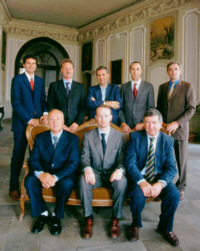 |
| The Barolo team from left to right: Pietro Ratti% Tino Colla% Giovanni Minetti% Emmanuele Baldi% Paolo Abbona (standing) and Manuel Marchetti% Cesare Benvenuto% Alberto Cordero di Montezemolo |
In the Barolo winegrowing region, eight producers have joined forces to form the so-called Barolo Team. A relatively loose association of eight producers of very different size and style wants to appear on the German market in future as the Barolo Team with joint forces. Tino Colla of Poderi Colla has a simple answer to the question of why these eight have come together: "In the meantime, a young generation has taken over the helm at the wineries. Competitive thinking is no longer so pronounced in this generation. The only thing they have in common is that they are friends and belong to the important producers in the Barolo area." In a slightly different constellation, the "Barolo Team" already existed 10 years ago. Back then, the team had its sights set on the US market.
Poderi Colla
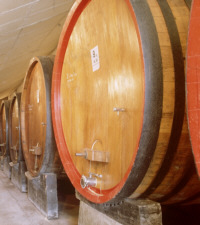 |
| Barrel cellar at Poderi Colla |
Tino Colla (born 1949) and his niece Federica (born 1965) founded Poderi Colla in 1994. It consists of the three estates Cascine Drago, Tenuta Roncaglia and Azienda Agricola Dardi le Rose. The latter produces the Barolo Bussia Dardi le Rose, the only Barolo of the estate. Before Colla acquired Dardi le Rose, the grapes from Dardi le Rose were sold to Barolo and Barbaresco producers. Dardi is both the estate name and the name of a sub-vineyard, the well-known Bussia site. The '97 is a typical representative of its vintage: very elegant, liquorice aromas, firm, clear fruit. The 98 of ripe fruit, very deep fruit and 99 (not yet released) with strong, ripe tannins and in its vintage-related robust manner.
Especially the ripe and high alcohol 98s show Colla's philosophy of harvesting the grapes only at physiological ripeness. "The grape is only ripe when the stems are red on the inside," he explains. That, Colla says, may well be "a few days after the time when the acidity and sugar levels in the grape suggest harvesting." To ripen physiologically, one or two cool nights are necessary. Only then does the vine switch to "winter mode", stop growing and the grapes can fully ripen.
Anyone who visits the likeable Tino at his Cascine Drago estate on the Bricco del Drago near Alba gets to know his extremely fascinating visitors' room. A detached building with panoramic windows overlooking the vineyards, it is equipped with historic wine-making equipment, such as the bottling machine on which Tino's grandfather produced sparkling wine according to the Champenoise method back in 1906.
In addition to Barbera and Dolcetto, which are common grape varieties in the Langhe, Colla also cultivates two exotics: Riesling and Pinot Nero.
Tino answers the question of why he and many other producers in Barolo have several estates, which, after all, complicates the reading of the label even more in addition to the vineyard designation, with the rules of the DOCG. In order to obtain DOC status, it is not enough that the grapes come from the corresponding region, but the winery must be based in the region. This is why many owner families, like Coderi Colla, have several farms.
Fontanafredda
 |
| Fontanafredda is the former hunting lodge of the first Italian king, Emmanuele II. |
Driving up the dedicated access road to this very traditional estate, passing the barrier and finally arriving at the buildings that make up Fontanafredda, you don't get the impression that you are visiting a winery. Fontanafredda is more like a small village. A village set in a large amphitheatre surrounded by vineyards, with residential buildings for 20 families, with winery facilities and literally majestic spaces. The estate belonged to the former royal family until 1931, when it was taken over by the current owner, Bank Monte die Paschi dei Siena. About 1,000 people used to live here. Today, about 100 people still work on the estate. 70 ha of vineyards are cultivated. Of these, the 45 ha around the estate are the largest contiguous vineyard in the Barolo region.
Fontanafredda is undisputedly the largest estate in the Barolo region. The fact that this is not necessarily connected with trivial mass wines is shown, for example, by the modern '98 Vigna Lazzarito Barolo.
Fontanafredda divides its Barolos into three lines, the basic line "Linea Tradizione", the "Linea Selezione" above it and the top line under the name "Fontanafredda", under which the four site Barolos are marketed.
A menu in the former royal chambers of the estate from the estate's own historically preserved kitchen is an experience, with risotto al Barolo, tagliata with white truffles and regional cheeses, the whole with Barolo from several decades in an ambience that is unparalleled. Anyone who experiences this can understand why there are people who are magically drawn to this region again and again.
Marcarini
 |
| The winery was founded in the 19th century. |
The lively and committed Manuel Marcarini worked in the clothing industry as a manager until 12 years ago, when he took over the winery of his wife Luisa's family, which was founded in the middle of the century. In the old cellar facilities, he now makes a Barolo that he himself describes as "traditional wine, but made in a modern way with constantly refined production methods". According to Marcarini, his customers "know what to expect from him". Therefore, he says, he has no reason to change his style. Modern wine is also a "good wine", but it loses much of its Barolo character.
With 30 to 45 days of maceration, he lives up to his reputation as a traditionalist. Nevertheless, he also strives for earlier drinkable wines. The problem with Barolo, says Marcarini, was always that because of the long waiting time, "everyone had a Barolo in the cellar, but no one drank a Barolo."
On his 16-hectare farm, he produces two Barolos in addition to Dolcetto, Barbera and other wines typical of the region:
Barolo Brunate: Brunate is a single vineyard near La Morra. According to Marcarini, this Barolo was sold at Marcarini with a site designation as early as 1958 and was thus the first site Barolo ever.
Barolo La Serra: Right next to the Brunate vineyard is the La Serra vineyard. This Barolo is considered to be gentler and more multi-faceted than the one from Brunate.
Marchesi di Barolo
Anyone visiting Marchesi di Barolo is first impressed by a large glass dome that spans the entire courtyard. Marchesi di Barolo is the second largest estate in the Barolo wine-growing region after Fontanafredda. Originally, the estate was owned by the Marchesa Falletti. The Falletti family is considered the "inventor" of the wine known today as Barolo. Today, the estate is owned by the Abbona family. Paolo and Ernesto Abbona run the estate today. Between traditionalists and modernists in Barolo, the Abbona brothers choose a middle path. They age part of their Barolo traditionally in large wooden barrels. Another part is produced in a modern way in French barriques.
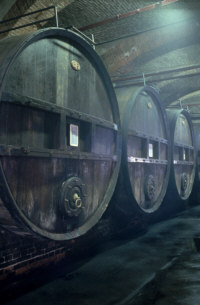 |
| Traditional historic wooden barrel |
Tradition is held very dear on this estate, in the middle of the village that gave its name to Barolo wine. In the cellar, the historic barrels are preserved and allegedly even still used. The tasting room is full of wines from earlier vintages, going back to 1893. Even this bottle is labelled "Barolo". Every year, 260 bottles of each vintage are put aside. A total of 25,000 bottles of wine are stored in this fascinating room.
Incidentally, the first wine was exported to Germany in 1975. The Hamburg fishmonger August Keller came to Barolo at the age of 15, tasted the wine and immediately ordered it in large quantities for his Hamburg customers. As a fishmonger, however, he only had a van more reminiscent of the sea at his disposal, which led to a refusal at the winery to load the wine. Only after a replacement vehicle had been procured could the first larger batch of Barolo from Marchesi di Barolo find its way to Germany.
What the fishmonger certainly couldn't enjoy back then is now an experience: the "Restaurant Marchesi di Barolo" with the kind of regional cuisine that lovers of the region call "the best cuisine in Italy".
The estate produces the Barolo Vigne di Proprietera, a blend from several vineyards. The 98 impresses with extremely ripe but very present tannins, the 99 has less pressure and less tannins and probably does not come close to its predecessor.
The Canubi, 40% of whose harvest was destroyed by storms in 2002, has more wood, is altogether more floral and varied on the nose. Here, the '99 is about on par with its predecessor from '98.
Must concentration has been used on the estate since 1992. Marchesi di Barolo was thus probably one of the pioneers of this technique. But here, too, it is emphasised how important the work in the vineyard and the right time of harvest are for the later result. Like Tino Colla, the opinion here is that the harvest should take place at the earliest after one or two days with strong temperature differences. These provide another important ripening boost for the tannins.
Cordero di Montezemolo
 |
| The cedar tree near the winery is visible from afar across the entire valley |
The brothers Giovanni and Enrico Cordero took over the winery from their father in 1987. The Cordero family's wine-growing tradition dates back to 1937. At that time, Paolo Cordero already produced a "Barolo". The vineyards are located in the area of the "blue Barolo" (see above) near the municipality of La Morra. The Barolos of Cordero di Montezemolo correspond to the type of the north-western half of the Barolo area: they are highly elegant. The best example of this is the elegant, fine but complex Vigna Bricco Gattera 97. This top wine of the estate, produced for the first time in 1997, grows around the large free-standing cedar tree, which has meanwhile become a symbol of the estate, if not of the entire Barolo region.
In the cellar we were able to admire a novelty. The cellar is permanently kept at a very high humidity level with the help of a fogging system. This is to reduce the loss of liquid during the ageing process in barriques. The system went into operation in October 2002. After only two weeks, the losses dropped from 40% to about 20%.
But even this cannot compensate for the huge losses that the Cordero family also had to suffer in 2002 due to bad weather. About half of the harvest was destroyed in this catastrophic year. Most affected is the Dolcetto.
Incidentally, it is gratifying that the first steps are being taken here to avoid another loss, namely that caused by cork damage later in the bottle: At least for Dolcetto, plastic corks are now being used. This is not possible for Barolo, as it is one of the DOCG's regulations to close Barolo with natural corks. This is despite the fact that, according to Giovanni Cordero, problems with cork damage have increased drastically in recent years.
A local speciality must also be mentioned here: Tajarin, which is a Piomontese variant of tagliatelle, of course freshly made with butter and white truffle. Accompanied by the estate's '98 Barolo Enrico VI. Anyone who has experienced this will always want to come back here in November.
Pio Cesare
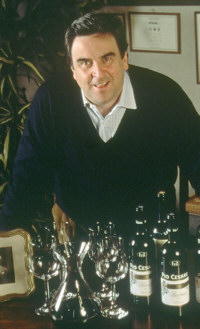 |
| Pio Boffa |
The farm is located in the middle of Alba, known as the truffle metropolis. Every year, huge numbers of tourists flock here to taste this local speciality and, of course, to buy some of it.
What is less well known is that business is also booming in and around Alba. Flat rents that are far above those of metropolises like Munich, for example, are one of the consequences.
This business also has a tradition that goes back over 100 years. The current owners Giuseppe Boffa (his wife Rosi is the granddaughter of the founder Pio Cesare) and Pio Boffa also see themselves as traditionalists. These two are supported by other family members: Cesare Benvenuto and Augusto Boffa. You should let Augusto Boffa explain to you how the family is connected. One experiences a witty, lively description of all the degrees of relationship, up to the adoption of the old family name "Cesare" as a first name by Cesare Benvenuto.
At present, the farm is being significantly expanded. Somehow the family has found space for an extension in the middle of the village, directly adjacent to the old cellars. Anyone looking at this knows that with the 50 hectares of vineyards that have been developed so far, the expansion plans are far from complete. Of course, there have also been considerations, says Cesare Benvenuto, to move the winery out of Alba, but they didn't want to do that. The family has always been based here in Alba," he says, "and we definitely don't want to change that.
The estate produces a total of 16 different wines. Among them is a speciality for the Langhe: a Chardonnay. This wine, marketed under the name "Piodilei", certainly leaves some of its models from Chablis behind in terms of quality! An incredibly powerful, mineral wine that you should definitely try.
But also the other wines of the estate, at the top the Barolo Ornato 98, impressively confirm that they know their craft here. With all due caution in view of the various tasting environments, this could be the best of all the 98 Barolo from the entire Barolo team.
Prunotto
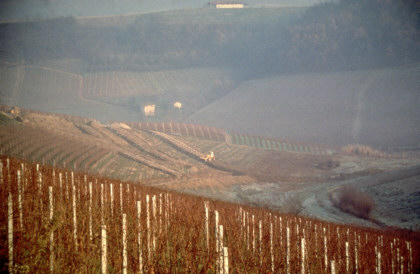 |
| The Bussia site in the mist so typical of the area |
Prunotto has had a chequered history. The winery emerged from the cooperative winery "Vini delle Langhe" in Alba. This was taken over by Alfredo Prunotto in 1923. He made his wines successful all over the world. In 1956, Prunotto handed over the winery to Beppe and Tino Colla. In 1989, the company passed to the Antinori family. The Colla brothers continued to run Prunotto until 1995, when they devoted themselves entirely to their own winery, which they had founded in the meantime.
The flagship of the wines is the Barolo Bussia, which is regularly awarded three glasses by the Gambero Rosso. Antinori acquired his own vineyards from the Bussia site in 1990. Until then, Prunotto only cultivated purchased grapes. Five years later, Prunotto acquired more land in the Agliano vineyard.
Renato Ratti
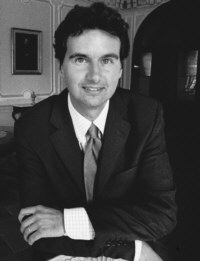 |
| Pietro Ratti% Like his father, Pietro Ratti sets standards for the production of local wines. |
Some describe Pietro Ratti as the driving force in the Barolo team. Anyone who gets to know the committed and lively Pietro Ratti can easily imagine this. His father Renato was also a "doer" for the interests of the Barolo region. He was the head of the producers' consortium. The widespread use of site designations in Barolo today also goes back to his initiative. He is also one of the pioneers of a modern Barolo style. A Barolo that, in contrast to the traditional style, is softer and more drinkable earlier on.
Modern wine style and historic cellar are not a contradiction. Renato Ratti has one of the oldest cellars in Barolo, which is said to date back to the 13th century. A visit to the winery is also worthwhile because of the winemaking museum. Historical tools, but also the first vineyard and terroir map of the Langhe created by Ratti can be seen there.
At the time of our visit (autumn 2002), Ratti was just starting the construction of a new cellar, which is being built into the mountain next to the old abbey of Annunziata.
Also with regard to his wines, Ratti is concentrating on the Marcenasco site, which surrounds the abbey and the future cellar.
The report is based on a visit to all the wineries in autumn 2002. Unfortunately, it was only possible to publish the report now.
Truffles - The Gold in AutumnIt is not only Barolo and other wines typical of the region that make the connoisseur's heart beat faster when he thinks of the Barolo region. The white truffle is just as present there as the wine, especially in autumn. This almost mystical plant, which grows in the woods around Alba at the roots of the trees, probably attracts more visitors to the region every year than the wine. They are hazelnut- to fist-thick tubers with a unique aroma. Planed into wafer-thin slices with a truffle slicer, they form an incomparable combination with the food served in the region and, of course, the Barolo wine, which delights every connoisseur.Or is it also the incredibly high price you have to pay for this speciality. Depending on the season and supply, you have to pay 1,000 to 2,000 euros per kg for the white truffle. So far, it has not been possible to cultivate the white truffle. The truffle hunter is therefore dependent on his luck, the good nose of his truffle dog and his experience, some of which goes back decades. A precise record is kept of every truffle found. The place where the truffle was found is covered up again. Experience shows that truffles prefer to grow in the same places over and over again. These records are therefore worth a fortune and are passed on from generation to generation. |